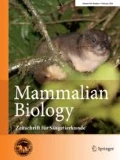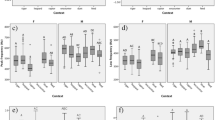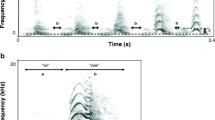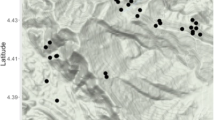Abstract
Determining the contexts of emission and information content of vocal signals can yield insights into the function of different call types, and remains an important step towards understanding the diversification of mammalian vocal repertoires. In this study, we used infra-red video cameras and remote audio recorders to document seasonal and contextual variation in male European badger (Meles meles) churr production over a 24-month period, and acoustic analysis based on source-filter theory to examine whether churr acoustic structure varies according to the caller’s arousal state and identity. Our behavioural observations revealed that male churrs are produced almost exclusively during the breeding season. Further contextual analysis showed that males emit churrs during close-range interactions with female conspecifics, often during copulation attempts, and churr directly into sett entrances. In addition, males involved in close-range social interactions delivered churrs with more call units per second than those vocalising without other conspecifics in close proximity. Discriminant function analysis also revealed that male churrs are individually distinctive, and confirmed that the formants (vocal tract resonances) contribute the most to caller identity. These findings indicate that badger churrs are sexual calls with the potential to signal male arousal state and identity in reproductive contexts. They also add to an increasing body of literature on the importance of formants for identity cueing in nonhuman mammals.




Similar content being viewed by others
References
Annavi G, Newman C, Buesching CD, Macdonald DW, Burke T, Dugdale HL (2014) Heterozygosity–fitness correlations in a wild mammal population: accounting for parental and environmental effects. Ecol Evol 4:2594–2609
Bachorowski JA, Owren MJ (1999) Acoustic correlates of talker sex and individual talker identity are present in a short vowel segment produced in running speech. J Acoust Soc Am 106:1054–1063
Blumstein DT, Munos O (2005) Individual, age and sex-specific information is contained in yellow-bellied marmot alarm calls. Anim Behav 69:353–361
Briefer EF, Maigrot A-L, Mandel R, Freymond SB, Bachmann I, Hillmann E (2015) Segregation of information about emotional arousal and valence in horse whinnies. Sci Rep 4:9989–9911
Buesching CD, Jordan N (2019) The social function of latrines: a hypothesis-driven research approach. In: Buesching CD (ed) Chemical signals in vertebrates. Springer, Cham, pp 94–103
Buesching CD, Macdonald DW (2004) Variations in scent-marking behaviour of European badgers Meles meles in the vicinity of their setts. Acta Theriol 49:235–246
Buesching CD, Stankowich T (2017) Communication amongst the musteloids: signs, signals, and cues. In: Macdonald D, Newman C, Harrington LA (eds) Biology and conservation of the musteloids (badgers, otters, skunks, raccoons and their kin). Oxford University Press, Oxford, pp 149–166
Buesching CD, Heistermann M, Hodges JK, Zimmerman E (1998) Multimodal oestrus advertisement in a small nocturnal prosimian Microcebus murinus. Folia Primatol 69:295–308
Buesching CD, Newman C, Macdonald DW (2002a) Variations in colour and volume of the subcaudal gland secretion of badgers (Meles meles) in relation to sex, season and individual-specific parameters. Mamm Biol 67:147–156
Buesching CD, Waterhouse JS, Macdonald DW (2002b) Gas-chromatographic analyses of the subcaudal gland secretion of the European badger (Meles meles) part I: chemical differences related to individual parameters. J Chem Ecol 28:41–56
Buesching CD, Stopka P, Macdonald DW (2003) The social function of allo-marking in the European badger (Meles meles). Behaviour 140:965–980
Charlton BD (2014) Vocal distinctiveness in the harsh coughs of southern hairy-nosed wombats (Lasiorhinus latifrons). Acta Acust united Ac 100:719–723
Charlton B, Zhang Z, Snyder R (2009) Vocal cues to identity and relatedness in giant pandas (Ailuropoda melanoleuca). J Acoust Soc Am 126:2721–2732
Charlton BD, Ellis WAH, McKinnon AJ, Brumm J, Nilsson K, Fitch WT (2011) Perception of male caller identity in koalas (Phascolarctos cinereus): acoustic analysis and playback experiments. PLoS ONE 6:e20329
Charlton B, Taylor A, Reby D (2013) Are men better than women at acoustic size judgements?. Biol, Lett, p 9
Charrier I, Mathevon N, Jouventin P (2001) Mother's voice recognition by seal pups - Newborns need to learn their mother's call before she can take off on a fishing trip. Nature 412:873–873
Christian S (1993) Behavioural ecology of the Eurasian badger: space use, territoriality and social behaviour. PhD thesis, University of Sussex.
Clutton-Brock TH, Albon SD (1979) The roaring of red deer and the evolution of honest advertising. Behaviour 69:145–170
Davies JM, Lachno DR, Roper TJ (1988) The anal gland secretion of the European badger (Meles meles) and its role in social communication. J Zool 216:455–463
Dugdale HL, Griffiths A, Macdonald DW (2011) Polygynandrous and repeated mounting behaviour in European badgers, Meles meles. Anim Behav 82:1287–1297
East ML, Hofer H (1991) Loud calling in a female-dominated mammalian society. 2. Behavioral contexts and functions of whooping of spotted Hyaenas Crocuta-Crocuta. Anim Behav 42:651–669
Ellis WAH, Bercovitch FB, FitzGibbon S, Roe P, Wimmer J, Melzer A, Wilson R (2011) Koala bellows and their association with the spatial dynamics of free-ranging koalas. Behav Ecol 22:372–377
Evans PGH, Macdonald DW, Cheeseman CL (1989) Social structure of the Eurasian badger (Meles meles): genetic evidence. J Zool 218:587–595
Fant G (1960) Acoustic theory of speech production. Mouton, The Hague
Fell RJ, Buesching CD, Macdonald DW (2006) The social integration of European badger (Meles meles) cubs into their natal group. Behaviour 143:683–700
Fitch WT (1997) Vocal tract length and formant frequency dispersion correlate with body size in rhesus macaques. J Acoust Soc Am 102:1213–1222
Fitch WT (2002) Primate vocal production and its implications for auditory research. In: Ghazanfar AA (ed) Primate audition: ethology and neurobiology. CRC Press, Boca Raton, FL, pp 87–108
Fitch WT, Hauser MD (1995) Vocal production in nonhuman-primates—acoustics, physiology, and functional constraints on honest advertisement. Am J Primatol 37:191–219
Frommolt KH, Goltsman ME, MacDonald DW (2003) Barking foxes, Alopex lagopus: field experiments in individual recognition in a territorial mammal. Anim Behav 65:509–518
Furuyama T, Kobayasi KI, Riquimaroux H (2016) Role of vocal tract characteristics in individual discrimination by Japanese macaques (Macaca fuscata). Sci Rep 6:1–8
Grady RM, Hoogland JL (1986) Why do male black-tailed prairie dogs (Cynomys ludovicianus) give a mating call? Anim Behav 34:108–112
Hardouin L, Tabel P, Bretagnolle V (2006) Neighbour-stranger discrimination in the little owl, Athene noctua. Anim Behav 72:105–112
Harrington FH, Mech LD (1979) Wolf howling and its role in territory maintenance. Behaviour 68:207–249
Insley SJ (2000) Long-term vocal recognition in the northern fur seal. Nature 406:404–405
Kruuk H, Gorman ML, Leitch A (1984) Scent-marking with the subcaudal gland by the European badger. Anim Behav 32:899–907
Lemasson A, Mikus M-A, Blois-Heulin C, Lodé T (2014) Vocal repertoire, individual acoustic distinctiveness, and social networks in a group of captive Asian small-clawed otters (Aonyx cinerea). J Mammal 95:128–139
Macdonald DW, Newman C, Buesching CD (2015) Badgers in the rural landscape—conservation paragon or farmland pariah? Lessons from the Wytham Badger Project. In: Macdonald DW, Feber RE (eds) Wildlife conservation on farmland. Conflict in the Countryside. Oxford University Press, Oxford, pp 65–95
Manno T, Nesterova A, DeBarbieri L, Kennedy S (2007) Why do male Columbian ground squirrels give a mating call? Anim Behav 74:1319–1327
McComb K, Moss C, Sayialel S, Baker L (2000) Unusually extensive networks of vocal recognition in African elephants. Anim Behav 59:1103–1109
McComb K, Reby D, Baker L, Moss C, Sayialel S (2003) Long-distance communication of acoustic cues to social identity in African elephants. Anim Behav 65:317–329
McShane LJ, Estes JA, Riedman ML, Staedler MM (1995) Repertoire, structure, and individual variation of vocalizations in the sea otter. J Mammal 2:414–427
Minter LJ, DeLiberto TJ (2008) Seasonal variation in serum testosterone, testicular volume, and semen characteristics in the coyote (Canis latrans). Theriogenology 69:946–952
Mumm CA, Knornschild M (2014) The vocal repertoire of adult and neonate giant otters (Pteronura brasiliensis). PLoS ONE 9:e112562
Neal E, Cheeseman CL (1996) Badgers. T & AD Poyser, London
Noonan MJ, Tinnesand HV, Müller CT, Rosell F, MacDonald DW, Buesching CD (2020) Knowing me, knowing you: anal gland secretion of European badgers codes for individuality, sex and social group membership. J Chem Ecol
Owren MJ, Rendall D (2001) Sound on the rebound: bringing form and function back to the forefront in understanding nonhuman primate vocal signaling. Evol Anthropol 10:58–71
Owren MJ, Seyfarth RM, Cheney DL (1997) The acoustic features of vowel-like grunt calls in chacma baboons (Papio cyncephalus ursinus): implications for production processes and functions. J Acoust Soc Am 101:2951–2963
Radwan J, Tkacz A, Kloch A (2008) MHC and preferences for male odour in the bank vole. Ethology 114:827–833
Reby D, McComb K (2003) Anatomical constraints generate honesty: acoustic cues to age and weight in the roars of red deer stags. Anim Behav 65:519–530
Reby D, Joachim J, Lauga J, Lek S, Aulagnier S (1998) Individuality in the groans of fallow deer (Dama dama) bucks. J Zool 245:79–84
Reby D, Cargnelutti B, Hewison AJ (1999) Contexts and possible functions of barking in roe deer. Anim Behav 57:1121–1128
Reby D, Hewison M, Izquierdo M, Pepin D (2001) Red deer (Cervus elaphus) hinds discriminate between the roars of their current harem-holder stag and those of neighbouring stags. Ethology 107:951–959
Reby D, Andre-Obrecht R, Galinier A, Farinas J, Cargnelutti B (2006) Cepstral coefficients and hidden Markov models reveal idiosyncratic voice characteristics in red deer (Cervus elaphus) stags. J Acoust Soc Am 120:4080–4089
Rendall D (2003) Acoustic correlates of caller identity and affect intensity in the vowel-like grunt vocalizations of baboons. J Acoust Soc Am 113:3390–3402
Roper TJ, Shepherdson DJ, Davies JM (1986) Scent marking with faeces and anal secretion in the European badger (Meles meles): seasonal and spatial characteristics of latrine use in relation to territoriality. Behaviour 97:94–117
Savill P, Perrins C, Kirby K, Fisher N (2010) Wytham Woods: Oxford's ecological laboratory. OUP, Oxford
Schwensow N, Eberle M, Sommer S (2008) Compatibility counts: MHC-associated mate choice in a wild promiscuous primate. Proc Roy Soc B 275:555–564
Semple S (2001) Individuality and male discrimination of female copulation calls in the yellow baboon. Anim Behav 61:1023–1028
Soltis J, Leong KM, Savage A (2005) African elephant vocal communication II: rumble variation reflects the individual identity and emotional state of callers. Anim Behav 70:589–599
Stewart PD, Macdonald DW (1997) Age, sex, and condition as predictors of moult and the efficacy of a novel fur-clip technique for individual marking of the European badger (Meles meles). J Zool 241:543–550
Stoeger AS, Charlton BD, Kratochvil H, Fitch WT (2011) Vocal cues indicate level of arousal in infant African elephant roars. J Acoust Soc Am 130:1700–1710
Stoeger AS, Baotic A, Li D, Charlton BD (2012) Acoustic features indicate arousal in infant giant panda vocalisations. Ethology 118:896–905
Taylor A, Charlton BD, Reby D (2016) Vocal production by terrestrial mammals: source, filter and function. In: Suthers RA, Fitch WT, Fay RR, Popper A (eds) Vertebrate sound production and acoustic communication. Springer International Publishing, Berlin, pp 229–259
Tinnesand HV, Buesching CD, Noonan MJ, Newman C, Zedrosser A, Rosell F, Macdonald DW (2015) Will trespassers be prosecuted or assessed according to their merits? A consilient interpretation of territoriality in a group-living carnivore, the European Badger (Meles meles). PLoS ONE 10:e0132432–e132420
Titze IR (1994) Principles of voice production. Prentice Hall, Englewood Cliffs
Townsend S, Charlton B, Manser M (2014) Acoustic cues to identity and predator context in meerkat barks. Anim Behav 94:143–149
Vannoni E, McElligott AG (2007) Individual acoustic variation in fallow deer (Dama dama) common and harsh groans: a source-filter theory perspective. Ethology 113:223–234
Wong J, Stewart PD, Macdonald DW (1999) Vocal repertoire in the European badger (Meles meles): Structure, context, and function. J Mammal 80:570–588
Yamaguchi N, Dugdale HL, Macdonald DW (2006) Female receptiveity, embryonic diapause, and superfetation in the European badger (Meles Meles): implications for the reproductive tactics of males and females. Q Rev Biol 81:1287–1297
Acknowledgements
A UCD Career Development Award provided financial support for this study. The fieldwork and data collection for this study were covered by the University of Oxford’s Natural England license 2014-5710-SCI-SCI and Home Office license PPL 30/2385. University College Dublin’s Animal Research Ethics Committee (AREC-E-16-15-Charlton) approved the capture of the acoustic data. We would like to thank Joni Avenell for her help processing the video data and Nigel Fisher for logistical support on-site.
Author information
Authors and Affiliations
Corresponding author
Additional information
Handling editor: Heiko Rödel.
Publisher's Note
Springer Nature remains neutral with regard to jurisdictional claims in published maps and institutional affiliations.
Rights and permissions
About this article
Cite this article
Charlton, B.D., Newman, C., Macdonald, D.W. et al. Male European badger churrs: insights into call function and motivational basis. Mamm Biol 100, 429–438 (2020). https://doi.org/10.1007/s42991-020-00033-x
Received:
Accepted:
Published:
Issue Date:
DOI: https://doi.org/10.1007/s42991-020-00033-x




